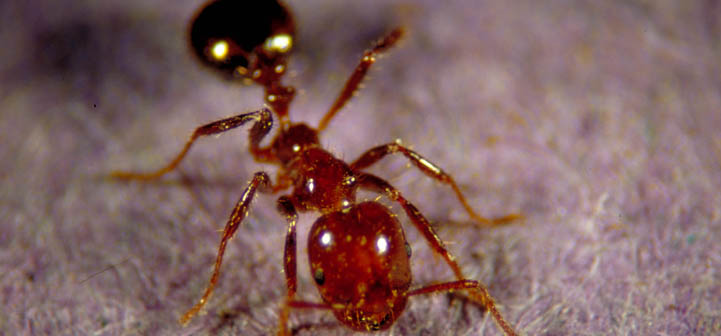Life Cycle Game Questions: TRUE or FALSE
Winged adults
- 1) Winged adults are most abundant in the late spring and early summer but can be found at any time of the year. TRUE
- 2) Winged adults are also known as “alates.” TRUE
- 3) Red imported fire ant male alates are much bigger than the female alates. FALSE
- 4) The nuptial flight of the male and female alates occurs at midnight. FALSE
- 5) The male alates fly out of the nest first and are joined by the female alates in the air. TRUE
- 6) After the nuptial flight the female alate lands, sheds her now useless wings and begins searching for a suitable nesting site. TRUE
- 7) Winged adults have four wings that are the same size. FALSE
- 8) The wings on the winged adults are clear (transparent) and hairless. TRUE
Eggs
- 1) A new queen only lays one egg to begin her new nest. FALSE
- 2) A new queen lays 10 to 15 eggs to start her new nest. TRUE
- 3) The eggs laid by the queen hatch in 7 to 10 days and are fed by the queen. TRUE
- 4) The feeding of the newly hatched eggs by the queen is by trophallaxis (mouth-to-mouth exchange of foods). TRUE
- 5) The queen can live up to 7 years and lay more than 1,000 eggs per day. TRUE
- 6) A new queen uses her wings to fly and search for food for her newly hatched eggs. FALSE
- 7) A new queen excavates a brood cell to lay her eggs in. TRUE
- 8) The eggs develop into male worker ants. FALSE
Larvae
- 1) The eggs hatch into larvae. TRUE
- 2) The larvae are black with 12 legs. FALSE
- 3) The larvae develop through four progressively larger stages called instars. TRUE
- 4) The larvae molt (shed their “skin”) between instar stages. TRUE
- 5) The larvae molt four times over a 12- to 15-day period. TRUE
- 6) The oldest larvae (last instar) digest the food given by the worker ants and secrete a nutritious liquid that the workers feed on and pass to the queen through trophallaxis. TRUE
- 7) Worker larvae are relatively small, while future queens and males (known as “reproductives”) develop from larger larvae. TRUE
- 8) The oldest larvae crawl around looking for food to feed the youngest larvae. FALSE
Pupae
- 1) The last larval instar becomes a pupa. TRUE
- 2) Instead of spinning a cocoon, the larva sheds its outer skin to reveal a pupa that gradually changes from white to brown. TRUE
- 3) The pupae are black with 12 legs. FALSE
- 4) Imported red fire ant pupae are all one size. FALSE
- 5) The pupae take 9 to 16 days to develop. TRUE
- 6) The pupa is the last stage before the adult. TRUE
- 7) The large pupae eat more food than the smaller pupae. FALSE
- 8) The pupae, part of the fire ant brood, develop into different size workers and winged forms. TRUE
Adult workers
- 1) All worker ants in the colony are females that sting but cannot lay eggs. TRUE
- 2) There is only one worker ant in each mound. FALSE
- 3) The worker ants feed and care for the queen ant. TRUE
- 4) The queen ant is fed by the worker ants through trophallaxis. TRUE
- 5) The largest workers in the colony can be as much as 10 times the size of the smallest workers. TRUE
- 6) The smallest workers are referred to as “minims.” TRUE
- 7) Young worker ants are assigned the job of caring for the developing brood. TRUE
- 8) Middle-aged worker ants maintain and protect the colony. TRUE
- 9) The oldest worker ants forage for food. TRUE
- 10) A fire ant mound can have more than one queen. TRUE
- 11) The fire ant queen leaves the mound once a day for fresh air. FALSE
If you need more questions in a section, change some of the TRUE statements to make them FALSE, or vice-versa, such as changing, “There is only one worker ant in each mound. (FALSE)” to “There are many worker ants in each mound. (TRUE)”
